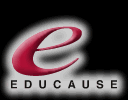|
|
Consortium Provides Opportunities for Technology in Higher Learning
|
|
|
|
Consortium Provides Opportunities for Technology in Higher Learning
|
|
 Technology has changed many things in our daily lives; how we work, play, communicate, and now how we learn. It's hard enough trying to keep up with the various macro changes in technology, but it becomes especially difficult applying those technologies in meaningful ways at the micro level. What makes sense or best fits our situation, our budget, and our needs? Sometimes the problem rests with where to even begin... Technology has changed many things in our daily lives; how we work, play, communicate, and now how we learn. It's hard enough trying to keep up with the various macro changes in technology, but it becomes especially difficult applying those technologies in meaningful ways at the micro level. What makes sense or best fits our situation, our budget, and our needs? Sometimes the problem rests with where to even begin......Enterprise portals, distance education, digital video, wireless networking, computer security, web-based instruction, digital copyrights... We find ourselves needing guidance on how to improve learning and administrative operations. We often ask, "how are other institutions doing it?" Even for those who are short on time or budget, there is a resource available: EDUCAUSE, an academic organization focused on using technology to help meet pedagogical goals and fuel educational technology exploration. EDUCAUSE was formed on July 1, 1998 through the merging of two like organizations, EDUCOM and CAUSE, whose combined experience in the IT higher education field amounts to sixty years. EDUCOM was primarily focused on instructional technologies that can help faculty improve learning. CAUSE was primarily focused on how to use technologies to improve the student learning process and/or organization. Eventually, it made sense to consider how technology was blurring these distinctions, since improvements by faculty, librarians, or administrators could affect one another. As such, EDUCAUSE became a "non-profit consortium of colleges, universities, and other organizations, dedicated to the transformation of higher education through the application of information technologies." To meet this goal, EDUCAUSE avails to its constituents a variety of opportunities and valuable resources. Conferences
Today, EDUCAUSE provides for the exchange of a wide array of resources between faculty, staff, and executive management. Each year EDUCAUSE organizes an annual conference featuring volunteer speakers from higher education institutions representing both the U.S. and other countries, usually focused on a specific theme (i.e., the "Edu Odyssey" from the October, 2001 conference). During the course of the year, a number of regional or topic specific conferences are organized across the United States (i.e., the EDUCAUSE Mid-Atlantic and Southeast Regional Conferences). Networking 200x was organized to bring together representatives from higher education and federal, local, and state governments on network policy issues. EDUCAUSE also promotes various affiliates like CUMREC (an organization for college and university computer users), which organizes a conference specifically focused on higher education administrative technologies.
Professional Development
EDUCAUSE also recognizes that it must do its part to groom the next generation of leaders within the higher education information technology field. Accordingly, EDUCAUSE holds a professional development program (The EDUCAUSE Institute) twice a year for higher education IT professionals. At the Institute, the Management Program and the Leadership Program are taught by many senior professionals in higher education. Opportunities supporting professional development are also available through awards and fellowships like the EDUCAUSE Ryland Fellowship.
Publications
Every three months EDUCAUSE releases its peer review journal EDUCAUSE Quarterly, which is aimed at "managing and using information technology and electronic information resources in higher education." Every two months it also releases its premier magazine EDUCAUSE Review that focuses on an array of topics, policies, perspectives, and practical opportunities. It also publishes a number of "white papers", monographs, and books through its Leadership Strategies Series, covering topics like "Information Technology in Higher Education: Assessing its Impact and Planning for the Future" or "The E is for Everything: E-Commerce, E-Business, and E-Learning in Higher Education."Every higher education faculty, administrator, and IT professional is encouraged to submit potential articles for publication as well, so don't be shy if you are doing something innovative that you think others would benefit from hearing about. Staying in Touch, Electronically
Finally, EDUCAUSE makes a wide range of information and documents available electronically. They have been diligently working on putting many of the papers, articles, video, audio, and presentations online through the EDUCAUSE Information Resources Library, through its Web site, and using "push" tools like Edupage, which delivers a three-times-a-week electronic digest of information technology news (to subscribe to Edupage, send a message to listserv@listserv.educause.edu and in the body of the message type "SUBSCRIBE Edupage YourFirstName YourLastName). EDUCAUSE has also been delegated responsibility by the federal government to manage the ".edu" domain names. They are now accepting applications to register ".edu" domain names via the EDUCAUSE Web site.
Getting Connected
To become connected to many of the resources mentioned in this article, you can start by going to the EDUCAUSE Web site (http://www.educause.edu/). There you can find invaluable resources to help answer questions you or others may have or to provide advice and guidance as you help shape the manner in which technology is used to promote learning, understanding, and services on campus. If you enjoy the experience you can also submit an application to join various volunteer boards and committees that make up EDUCAUSE (i.e., the EDUCAUSE Program Advisory Board, Advisory Committee on Teaching and Learning, the EDUCAUSE Quarterly Editorial Committee, and the Evolving Technologies Committee to name a few).Send us your comments on this story. |
|
|